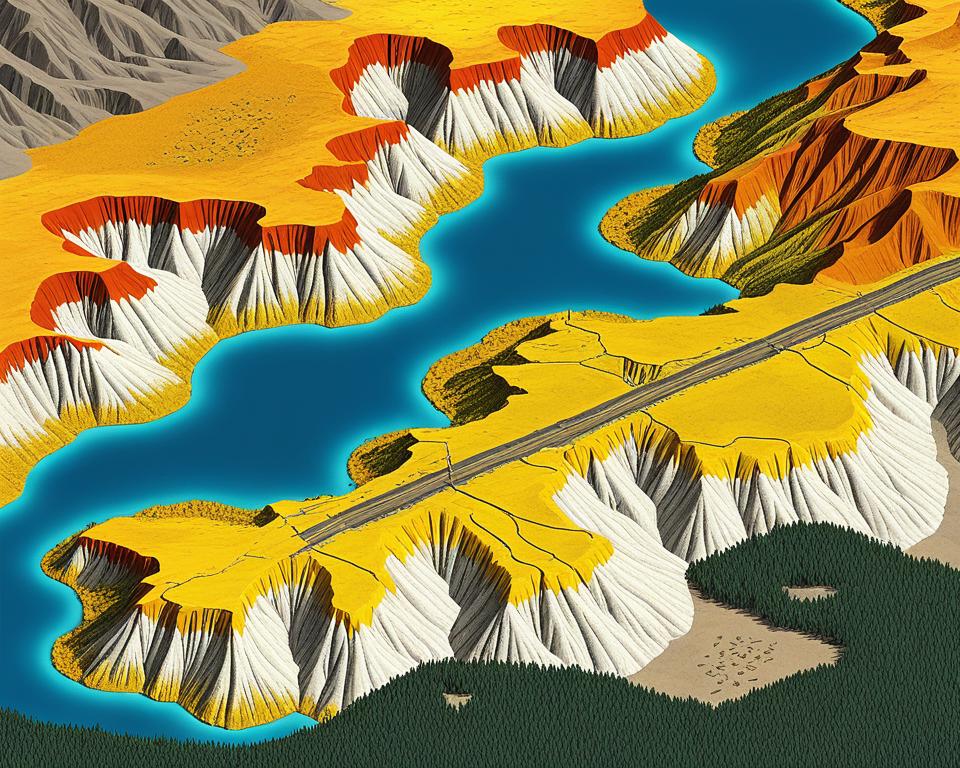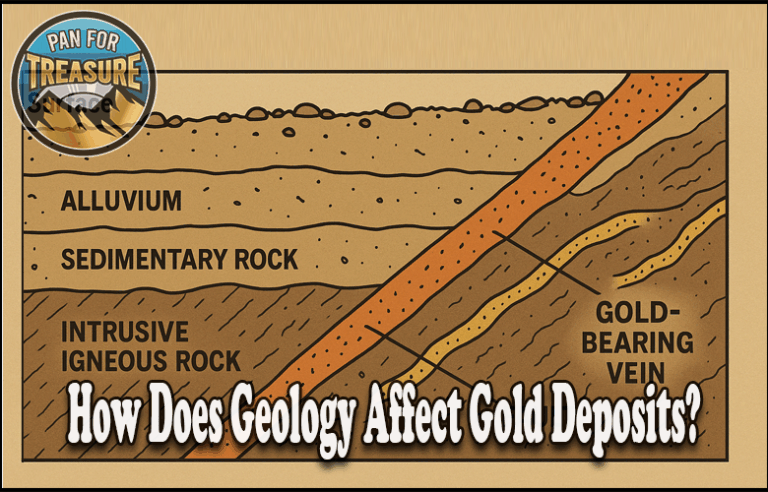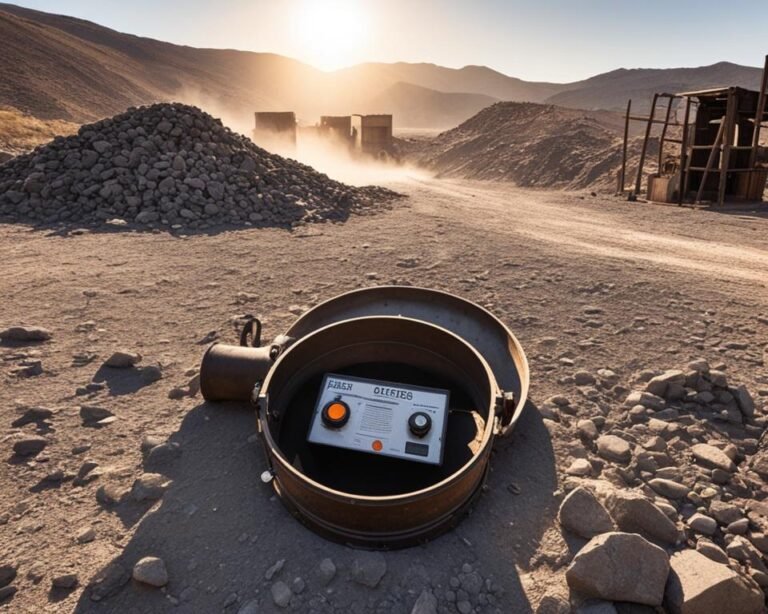Disclosure: This Post Contains Affiliate Links; We earn a commission on purchases.
Gold is an economically important metal with various uses in jewelry, coins, electronics, dental materials, and industrial applications. Understanding the different types of gold deposits is crucial for exploration and mining. There are several types of gold deposits, each formed in unique geological environments and characterized by distinct features.
Key Takeaways
- Gold deposits come in various types, each with its own geological characteristics and formation processes.
- Types of gold deposits include placer, lode, epithermal, hypothermal, mesothermal, alluvial, and supergene deposits.
- Epithermal gold deposits are formed in volcanic or magmatic environments and often contain high concentrations of silver.
- Hypothermal gold deposits form at high temperatures and depths within the Earth’s crust, associated with magmatic activity.
- Mesothermal gold deposits are intermediate in temperature and found in greenstone belts and turbidite-hosted sequences.
Epithermal Gold Deposits
Epithermal gold deposits are a fascinating geological occurrence that forms in volcanic or magmatic environments. These deposits are known for their unique characteristics, which set them apart from other types of gold deposits.
Epithermal gold deposits are formed under relatively low temperatures and at shallow depths, making them accessible for mining operations. These deposits often contain high concentrations of silver, making them economically valuable.
One of the notable features of epithermal deposits is their association with regions of volcanic activity. These volcanic environments provide the ideal conditions for the formation of epithermal gold deposits.
Hot springs are often closely associated with epithermal deposits. These hot springs influence the mineralization process and can result in the rich presence of quartz, sulfides, and other minerals within the deposits.
To further understand the characteristics of epithermal deposits, let’s take a closer look at their formation process:
- Volcanic or magmatic activity creates the conditions necessary for the formation of epithermal deposits.
- As the volcanic or magmatic fluids rise to the surface, they interact with the surrounding rocks, leading to the deposition of gold and other minerals.
- The low temperatures and shallow depths at which these deposits form contribute to their unique composition.
- The presence of hot springs facilitates the deposition of minerals and enhances the overall richness of the deposits.
Epithermal gold deposits have significant implications for mining operations. Their relatively shallow depths and accessible locations make them economically viable targets for exploration and extraction.
Now that we’ve explored the characteristics and formation process of epithermal gold deposits, let’s move on to the next section to learn about another type of gold deposit.
Hypothermal Gold Deposits
In the world of gold deposits, hypothermal gold deposits stand out as valuable treasures hidden deep within the Earth’s crust. These deposits are formed under extreme heat and pressure, making them a highly sought-after source of gold. Typically associated with magmatic activity, hypothermal deposits can be found in regions characterized by granitic or dioritic rocks.
What sets hypothermal gold deposits apart is their remarkable concentration of this precious metal. These deposits can contain substantial amounts of gold, making them particularly attractive to mining companies and investors. A defining feature of hypothermal deposits is the presence of quartz veins and sulfide minerals, which serve as indicators of the gold-rich ores within.
Hypothermal gold deposits are like hidden treasures waiting to be unearthed. They hold the promise of substantial wealth and are a testament to the Earth’s geological processes.
Exploring and extracting gold from hypothermal deposits requires advanced mining techniques and technologies due to their depths and complex geological formations. The value of these deposits lies not only in the abundance of gold but also in the potential for discovering other precious minerals and metals.
The Geological Formation of Hypothermal Gold Deposits
Hypothermal gold deposits are born from the interaction of magmatic fluids and rocks deep within the Earth’s crust. As magma rises towards the surface, it carries with it mineral-rich fluids, including gold, which become concentrated in fractures and faults within the surrounding rocks.
Over time, as the magma cools and solidifies, it leaves behind a network of quartz veins and sulfide minerals that harbor the precious gold. These deposits can extend vertically for hundreds of meters and can stretch horizontally for significant distances, creating vast reservoirs of gold just waiting to be discovered.
Unlocking the Riches of Hypothermal Gold Deposits
Mining hypothermal gold deposits requires a combination of geological expertise, advanced exploration techniques, and innovative extraction methods. Geologists study the rocks, structures, and mineralogical composition of these deposits to identify the most prospective areas for gold extraction.
Advanced drilling technologies, such as diamond drilling, are used to sample the ore bodies and determine their potential yield. Once the ore is extracted, it undergoes intricate processes, including crushing, grinding, and flotation, to separate the valuable gold from the surrounding rock and minerals.
As the mining industry continues to evolve, new technologies and approaches are being developed to extract gold from deeper and more challenging hypothermal deposits. These advancements ensure that the world can continue to benefit from the economic value and beauty of this precious metal.
| Advantages of Hypothermal Gold Deposits | Challenges of Hypothermal Gold Deposits |
|---|---|
|
|
Mesothermal Gold Deposits
Mesothermal gold deposits occupy an intermediate position in terms of temperature and depth compared to epithermal and hypothermal deposits. These deposits are known for their association with greenstone belts and turbidite-hosted sequences. Mesothermal gold deposits are often found in regions with extensive tectonic activity and can be associated with shear zones.
One of the defining characteristics of mesothermal deposits is their potential for containing high-grade gold ores. These deposits can host significant amounts of gold, making them economically valuable. However, the mining process for mesothermal deposits can be complex and challenging due to their geological history and structural complexities.
Understanding the formation and characteristics of mesothermal gold deposits is crucial for successful exploration and mining operations. These deposits offer opportunities for extracting high-grade gold ores, contributing to the global gold production.
Placer Gold Deposits
Placer gold deposits, formed by the erosion and deposition of gold-bearing materials, offer a fascinating opportunity for gold extraction. These deposits are primarily found in riverbeds, floodplains, and beach sands, created through natural geological processes. Placer deposits are abundant in areas with significant erosion, making them valuable sources of fine-grained and nugget gold.
Easily accessible and easily mined, placer deposits have attracted gold enthusiasts for centuries. Miners have employed simple and effective techniques such as panning and sluicing to separate the gold from the surrounding materials. These methods capitalize on the density of gold, enabling the valuable metal to settle while lighter materials are washed away.
Placer deposits have played a significant role in historical gold rushes, drawing fortune seekers and shaping entire regions. The allure of striking it rich fueled dreams of wealth and adventure, with iconic tales from the California Gold Rush and the Klondike Gold Rush capturing the imagination of generations.
Here is a brief overview of some key features of placer gold deposits:
- Formed by erosion and deposition of gold-bearing materials
- Located in riverbeds, floodplains, and beach sands
- Abundant in areas with significant erosion
- Contain both fine-grained and nugget gold
- Mined using techniques such as panning and sluicing
- Have played a significant role in historical gold rushes
To gain a deeper understanding of placer gold deposits, take a look at the table below, which compares placer deposits with other types of gold deposits:
| Type of Deposit | Formation Process | Location | Gold Characteristics | Mining Techniques |
|---|---|---|---|---|
| Placer Deposits | Erosion and deposition of gold-bearing materials | Riverbeds, floodplains, beach sands | Fine-grained and nugget gold | Panning, sluicing |
| Lode Deposits | Hydrothermal processes | Quartz veins, fractures within rocks | Significant amounts of gold | Underground mining methods |
| Epithermal Deposits | Volcanic or magmatic environments | Regions of volcanic activity | High concentrations of silver | N/A |
As you can see, placer gold deposits are unique in their formation and characteristics, making them a fascinating aspect of the gold exploration and mining industry. Whether you’re an avid gold enthusiast or simply intrigued by geological processes, studying placer deposits provides valuable insights into the world of gold.
Lode Gold Deposits
In the world of gold mining, lode gold deposits hold a special place. Also known as hard rock or vein gold deposits, these formations are formed through hydrothermal processes deep within the Earth’s crust. Lode deposits are typically found in quartz veins or other fractures within rocks, making their extraction a unique challenge.
Lode gold deposits often contain significant amounts of gold, making them highly valuable. These deposits can be high-grade, meaning they have a high concentration of gold per ton of rock. As a result, lode deposits have been a major source of gold production throughout history.
While other types of gold deposits may be accessible through surface mining methods, lode deposits are usually found at depths that require underground mining. Miners must navigate complex and sometimes treacherous underground tunnels to reach the gold-bearing veins. This process requires specialized equipment and expertise.

Mining Techniques for Lode Gold Deposits
The extraction of gold from lode deposits requires sophisticated techniques to access the mineralization. Here are some common methods used:
- Underground mining: This method involves sinking vertical or inclined shafts to access the gold-bearing veins. Miners then use drilling, blasting, and other methods to extract the ore.
- Stoping: Stoping is a technique used in underground mining to remove the ore from the veins. Various methods, such as cut-and-fill, shrinkage, and long-hole stoping, are employed depending on the specific characteristics of the deposit.
- Milling: Once the ore is extracted, it is milled to liberate the gold particles from the surrounding rock. This is typically done through crushing, grinding, and chemical processes.
Lode gold deposits have played a significant role in shaping the history of gold mining. Famous mines like the Homestake Mine in South Dakota, which produced millions of troy ounces of gold, exhibit the richness of lode deposits. These deposits continue to attract exploration and mining efforts as they offer the potential for high-grade gold ores.
| Advantages of Lode Gold Deposits | Disadvantages of Lode Gold Deposits |
|---|---|
| Lode deposits can contain significant amounts of gold, making them economically valuable. | Extraction of gold from lode deposits requires expensive and complex underground mining operations. |
| Lode deposits can be high-grade, allowing for efficient gold recovery. | Underground mining operations pose safety risks to miners due to the complex and confined working environment. |
| Lode gold deposits have the potential to sustain long-term mining operations. | Lode deposits may be limited in size and extent, making it necessary to continually explore new areas for future production. |
Primary and Secondary Gold Deposits
Gold deposits come in various forms, and they can be classified into two main categories: primary deposits and secondary deposits. Understanding the differences between these types of deposits is essential for effective gold exploration and mining.
Primary Gold Deposits: These deposits are formed directly by geological processes and are considered the original source of the gold. Two common types of primary deposits are lode deposits and placer deposits.
“Lode deposits are typically found in quartz veins or fractures within rocks. They result from hydrothermal processes and can contain significant amounts of gold.
Placer deposits, on the other hand, are formed by the erosion and deposition of gold-bearing materials. They can be found in riverbeds, floodplains, and beach sands. Placer deposits are often accessible through simple mining techniques like panning and sluicing.”
Secondary Gold Deposits: These deposits are formed by the redistribution of gold from primary deposits to different geological settings. Common types of secondary deposits include eluvial, alluvial, and supergene deposits.
“Eluvial deposits are formed when gold particles are weathered and remain in the same area where they originally formed, such as on hillsides and slopes.
Alluvial deposits are formed when gold particles are transported by rivers and deposited in riverbeds, floodplains, and deltas. These deposits are typically found downstream from the source of the primary gold deposit.
Supergene deposits are formed near the surface through weathering processes. They occur when primary gold deposits are oxidized and leached, leading to the concentration of gold in residual clays and soils.”
The distinction between primary and secondary gold deposits is crucial in determining the economic viability and feasibility of gold mining projects. Primary deposits are often the focus of extensive exploration efforts, while secondary deposits can provide opportunities for mining in areas where primary deposits are scarce or depleted.
Understanding the geological processes behind the formation of primary and secondary gold deposits is key to identifying potential gold-rich regions and optimizing mining operations.
Other Types of Gold Deposits
Besides the main types mentioned above, there are several other types of gold deposits. These include intrusion-related breccia pipes, contact deposits (skarns), replacement deposits, disseminated ores, and Archean banded-iron formation deposits. Each of these deposit types has its own unique characteristics and geological formation processes.
Let’s take a closer look at these other types of gold deposits:
- Intrusion-related breccia pipes: These types of deposits are formed by the fracturing and brecciation of surrounding rocks caused by the intrusion of magma. Gold-rich fluids then infiltrate these fractured rocks, resulting in the formation of gold deposits.
- Contact deposits (skarns): Contact deposits occur when hydrothermal fluids interact with and alter the surrounding rocks, often occurring at the contact zone between an intrusive igneous rock and a carbonate or calcareous sedimentary rock. Skarns can be rich in gold and other minerals.
- Replacement deposits: Replacement deposits form when pre-existing minerals are replaced by gold-bearing minerals. These deposits are often associated with hydrothermal activity and can be found in various geological settings.
- Disseminated ores: Disseminated deposits are characterized by the widespread distribution of gold mineralization within a host rock. These deposits often occur in porphyry copper deposits or in the surrounding alteration zone.
- Archean banded-iron formation deposits: Banded-iron formation deposits are formed in ancient Precambrian rocks and are often associated with volcanic and sedimentary processes. These deposits can contain significant amounts of gold along with iron oxides.
Understanding these various types of gold deposits is crucial for the identification and exploration of gold resources. Each deposit type presents unique challenges and opportunities for mining companies seeking to extract gold.

Case Study: Homestake Mine
The Homestake Mine, located in South Dakota, serves as an illustrious case study for the remarkable banded-iron formation gold deposit. This mine has been a prolific producer, yielding millions of troy ounces of gold and subsequently earning its reputation as one of the most valuable mines in the United States.
The gold deposits at the Homestake Mine form a close association with banded iron formations and metavolcanic rocks, a distinctive geological feature that sets it apart from other deposits. This unique formation process has facilitated the development of significant gold reserves, making the Homestake Mine a prime site for exploration and extraction.
Visual representation of a banded-iron formation deposit: banded-iron formation deposit.
Homestake Mine Statistics
| Location | South Dakota, United States |
|---|---|
| Gold Production | Millions of troy ounces |
| Formation Type | Banded-Iron Formation Deposit |
| Geological Association | Banded iron formations and metavolcanic rocks |
| Main Mining Method | Underground mining |
The Homestake Mine’s extensive gold production and geological significance have contributed significantly to the understanding of banded-iron formation deposits and their potential for yielding substantial gold resources. As an exceptional case study, the Homestake Mine continues to captivate researchers and mining enthusiasts alike, shedding light on the intricate processes involved in gold formation and extraction.
Conclusion
Gold deposits are diverse in nature, encompassing various geological characteristics and formation processes. Understanding these different types of gold deposits is crucial for effective exploration and mining activities. Whether it’s the erosion-formed placer deposits or the hydrothermal-formed lode deposits, each type of gold deposit offers unique opportunities for extraction and significantly contributes to global gold production.
By studying the geological environments in which these deposits are found, geologists and mining companies can better identify potential gold-bearing areas. This knowledge allows for targeted exploration efforts, ultimately leading to more efficient and successful mining operations. The variety of gold deposits available ensures a continuous supply of this precious metal to meet the demands of various industries worldwide.
With its economic importance and widespread applications, gold continues to play a vital role in our society. From jewelry and coins to electronics and industrial use, gold’s value remains consistently high. The diverse array of gold deposits ensures a steady supply of this valuable metal, contributing to economic growth and stability. As technology advances and new mining techniques are developed, the future of gold mining looks promising with the potential for even greater discoveries.
Source Links
- https://serc.carleton.edu/research_education/nativelands/pineridge/golddeposits.html
- https://www.911metallurgist.com/blog/classification-of-gold-deposits-auriferous
- https://pubs.geoscienceworld.org/segweb/books/book/2314/chapter/131183045/Chapter-1-Gold-Deposit-Types-An-Overview

Meet Ryan Conlon, the passionate owner and driving force behind Pan for Treasure.
With an unwavering love for the art of gold panning, Ryan has transformed his enthusiasm into a thriving community hub for fellow treasure seekers. info@panfortreasure.com
A seasoned gold panning enthusiast, Ryan’s journey began with a simple pan and a dream, evolving into a deep appreciation for the history, geology, and thrill of uncovering precious metals.
Subscribe to Our Newsletter







